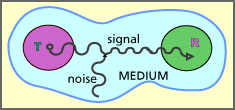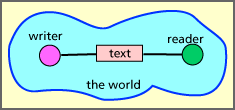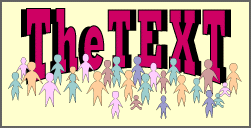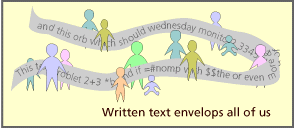
 TUTORIAL: MASS COMMUNICATION
TUTORIAL: MASS COMMUNICATIONINTRODUCTION . TEXT . TEXT AND MEANING . DATA AS TEXT . THE MASS MEDIA . CHANNELS OF DISTRIBUTION . AUDIENCES . MEDIA ORGANIZATIONS . CONTENT . SOCIAL INSTITUTIONS .
By removing words from the world of sound where they had first had their origin in active human interchange and relegating them definitively to visual surface, and by otherwise exploiting visual space for the management of knowledge, print encouraged human beings to think of their own interior conscious and unconscious resources as more and more thing-like, impersonal and religiously neutral. Print encouraged the mind to sense that its possessions were held in some sort of inert mental space. - Walter J. Ong
For much of human history speech and body language were the only available forms of communication. This changed when writing was developed, probably around the year 3000 BC in the area of the world that we now call the Middle East.
The most obvious difference between writing and speech is in their media. Whereas speech is carried by sound waves in the air, writing is usually carried by one substance impressed upon another, as, for example, ink on paper. [Note] Even in its simplest form, the invention of writing produced significant changes in human communication.
The next major change came with the discovery of printed text in Europe in the late 1500s. Whereas written documents could only be produced by individuals, one document at a time, printed documents could be mass produced. The phenominon that we now call mass communication dates from the invention of print.
Some scholars argue that the next great change occurred in or around 1950 with the discovery of the computer. However, while digital data processing certainly has brought changes to our society, we are perhaps too close to the date of its birth to evaluate it clearly.
The fact that writing remains in existence long after it has been created is so remarkable that we give a special name, text, to the visible remains. Humans receive textual messages via their eyes. It has been argued that this visual aspect of text is important in and of itself because it shapes the way human beings pay attention to their environment, and this shapes the way that they think about themselves.
Text-using societies tend to be visually oriented, whereas speech-using societies tend to be aurally oriented. Thus, when scholars initiated the study of text, they discovered that communication not only helps shape individual relationships, but it also plays a role in defining the social environment.
Those who study communication disagree as to the exact definition of the term, "text." In its broadest sense text is "that which is perceived by the reader," however, this conceivably could be any data that is taken in by the eye, and to many this seems to be too broad a concept. This section of the tutorial will limit the discussion to the narrower definition of text as "print," by which is meant marks made in one substance upon another.
As was shown earlier, the Shannon/Weaver Model describes communication as a process that includes a transmitter who initiates the communication, a signal that moves through a medium, a receiver who notices the signal, and noise that may alter the signal.

In terms of this model, text can be seen as being
created by the writer and then moving
 through time and space until it is
encountered by the reader. The medium is light waves, and the signal is
formed as light bounces off of the paper and ink and into the reader's eyes. While the
text is in transit, noise may act to make it less understandable -- the writing
may fade, for example, or pages may be torn or missing.
through time and space until it is
encountered by the reader. The medium is light waves, and the signal is
formed as light bounces off of the paper and ink and into the reader's eyes. While the
text is in transit, noise may act to make it less understandable -- the writing
may fade, for example, or pages may be torn or missing.
This is accurate as far as it goes, but it does little to demonstrate how text relates to meaning. However, it is possible to produce a somewhat different model that is more amenable to the discussion of meaning.
In this model the reader, the writer
 and the text exist in the world, which is their environment and with which they interact. The reader and the writer interact directly with the text, and indirectly with one another by means of the text, which itself becomes a medium of communication. Thus, reader, writer and text are seen as an interconnected system.
and the text exist in the world, which is their environment and with which they interact. The reader and the writer interact directly with the text, and indirectly with one another by means of the text, which itself becomes a medium of communication. Thus, reader, writer and text are seen as an interconnected system.
One way to interpret this model is to imagine that the writer, who has thoughts to communicate, expresses them by creating a text. The reader and the writer share a language code, and so when the reader encounters the text, he or she becomes the receiver of the writer's thoughts.
But this description leads to a number of perplexing questions. For example:
Attempts to answer these and similar questions have produced four basic approaches to explaining the relationship between text and meaning. Not surprisingly, these conflict with one another. As each is examined in turn, keep in mind this question: Which of these is most responsible for the meaning of a text:
 when Herman Melville wrote Moby Dick, he intended for us to read
the book and understand his thinking on the subject.
when Herman Melville wrote Moby Dick, he intended for us to read
the book and understand his thinking on the subject.
From this point of view, the focus is on what the writer meant to say, and the reader's task is to discern the author's thoughts. Thus, when we consider what it might mean that the protagonist whale in Moby Dick is colored white, the question we must ask is, "Why did Herman Melville choose to make his whale a white one?"
Military orders are an example of a kind of text that is well described by this
approach. In a "military order" the intention of the writer is paramount. There is no
doubt that he or she intends that a particular meaning be conveyed, and if the
reader has any uncertainty of the meaning of the text, that ambiguity must be
resolved by attempting to understand what the writer was trying to say. The
reader has no leeway for interpreting the text on his or her own.
![]() 6033
6033
When the reader encounters such a text, he or she cannot be completely certain
as to which of these meanings the writer intended. Further, the reader has led
 a life which contains different experiences that of the writer. Consequently,
the reader is likely to make of the text something other than what the writer
might have expected.
a life which contains different experiences that of the writer. Consequently,
the reader is likely to make of the text something other than what the writer
might have expected.
In fact, those who adopt this approach point out that the reader need have no knowledge of the writer at all. Nor does the reader need to be concerned as to the writer's intentions. When the reader draws a meaning from the text, then that meaning is the reader's and the reader's alone.
Anonymous text fits this approach well, but in fact, any text that is read without knowledge of its author lends itself to the reader-oriented approach.
For example, consider this quotation:
"And she understood that the hour had come to herself." - The Author
Certainly, this sentence is understandable and will have meaning to most of its
readers, even if the meaning is only "this is a quote from somewhere." But,
with no knowledge of the author, and without the context of the rest of the
document, how can we say that the author's intended meaning comes through?
"We cannot," argue the proponents of the reader-oriented approach -- "meaning
is in the mind of the reader."
![]() 6004
6004

This approach is adopted most frequently by those who study sacred texts. These, having been created by a deity, are taken to be composed entirely of truths, and in fact, it is not unusual for such texts to assert this as a primary fact. For example:
In the beginning was the Word, and the Word was with God, and the Word was God. - John 1.1, Harper Study Bible, Revised Standard Version
Every Word of God proves true... - Proverbs 30.5, Harper Study Bible, Revised Standard Version
And similarly:
The basic book of Islam is the Koran. This is believed to be the divine law of God as uttered by Allah himself in revelations to Mohammed, and passed on by the Prophet through word of mouth.... The authority of the Koran is believed by good Moslems to be absolute. It is without any question the most influential, and the most widely read book in all Arabic literature, and probably the most faithfully read scripture in the world. - The Portable World Bible, ed. Roberto Ballou, Penguin Books, 1986.
If a text is taken in and of itself to contain the truth, then neither the intentions of its human writers nor the interpretations of its readers are relevant. The meaning is in the text, and if two readers disagree, then they must consult the text further in attempting to resolve the disagreement. There is no other authority.
A telephone directory is a good example of a text that lends itself to this
approach. A book that contains only names and phone numbers, and assuming that
there are no errors, contains only the truth. As readers, we consult the book
and take what it says as fact.
![]() 6002
6002
A fourth approach attempts to resolve this dilemma by considering text as part of the human social environment. According to this approach, each author adds to the "communication environment," and each reader takes meanings from it. When considered from this point of view, the text is not separate from the world, but is part of it. Writers and readers, who are also part of the world, participate in the "textual experience."

As an example, consider the text called a "newspaper." Because many writers and editors contribute to each edition, there is no way to identify a single "author." As readers read the paper, they compare what they read to their experience in the world, and they discuss what they read with other readers. The meanings that readers take from the newspapers become the raw material of other texts, including such as the television and radio news of the day, and the next day's newspapers. The text of the newspaper is stored in libraries and other archives where it can be referenced at any time. Thus, the text becomes part of the fabric of the life of a society.
This goes deeper than the simple thought that "everyone reads more or less the same text." Because the codes by which humans communicate are shared by all members of the society, they, too, are part of the communication environment. This means that the texts, the people, the interpretations, and the rules that govern the interpretations are all mutually interactive.
For example, we might again consider the quote that was presented earlier:
And she understood that the hour had come to herself.
While readers may have no knowledge of the author of this quotation, they are not completely free to interpret the text however they might wish. The language codes that constrain the interpretation insist that the person referenced in the sentence be identified as female; that she be seen as thinking about her personal situation; and that her thoughts be considered as having something to do with time.
In the same way that readers of this tutorial will share these particular meanings, all members of any particular society share a tremendously rich environment of other meanings which derive from their common codes and their common reservoirs of text.
The fourth, or cultural approach
points out that these resources are applied in different ways at different times.
Sometimes humans express their intention as authors, sometimes they develop unique
connotations as readers, sometimes they search for eternal truths. Thus, the
common ground of text is found in the two complementary faces of human
communication: the society and the self.
![]() 6001
6001
![]() 6006.
6006.
Let it be emphasized that the communication of information does not necessarily imply the use of language, nor consciously perceived sending or receiving, nor consciously intended communication, nor consciously noted understanding. As already noted, every act, every pause, every movement in living and social systems is also a message; silence is communication; short of death it is impossible for an organism or a person not to communicate.Wilden 124
Thus, those who accept the existence of the communication environment, are driven to conclude that any source of information might be considered as text.
For example, natural phenomena can be "read" -- a red sunset tells the watcher that it
might rain tomorrow, flocks of geese flying south indicate that winter is near,
and so on. In terms of this approach, scholars may view the physical world as a
large, complex text which communicates a part of reality to its human readers.
This notion is similar to the text-oriented approach that was described above -- the world is a text whose meaning is "true," and as observers, humans must try to puzzle out its meaning.
![]() 6003
6003
![]() 6007
6007